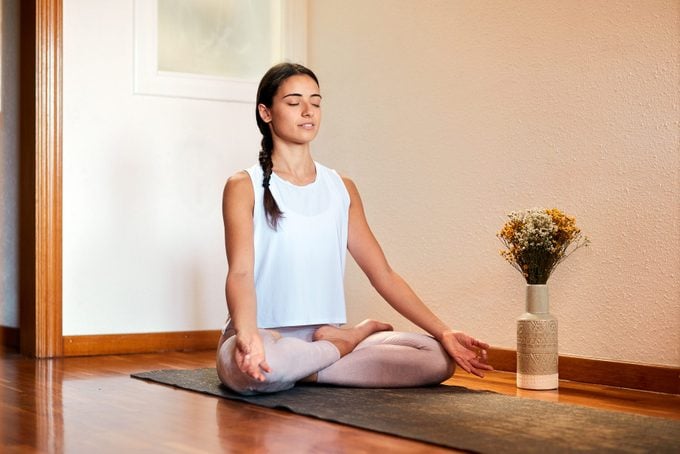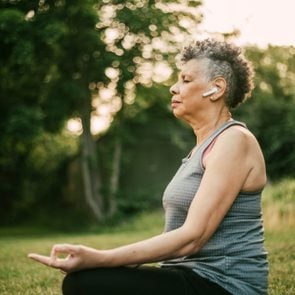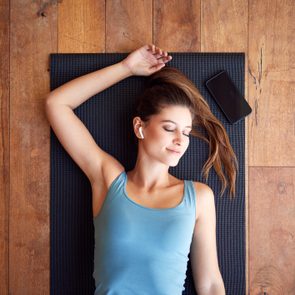Create the Ultimate Meditation Space: Mindfulness Experts Share 4 Easy Ideas
Updated: Mar. 08, 2022
Appointing a comfy spot all of its own could be just the inspiration you need to solidify your meditation practice. Here are the essentials for your meditation space, from wellness authorities.
Our editors and experts handpick every product we feature. We may earn a commission from your purchases.
Make your meditation space peaceful
Need a breather? “Us too,” says everyone. Managing stress isn’t just good for your peace of mind—in fact, January 2022 biomedical research at England’s University of Nottingham suggests stress might actually increase your risk of catching Covid-19.
Fortunately, science shows meditation is one of the most effective ways to deal. A meditation practice requires little more than breathing… but the potential health benefits of meditation are impressive. Research shows meditating regularly can help lower blood pressure, lessen anxiety, and even manage chronic pain. Another huge plus is that you can access your meditation practice just about anytime you need it, anywhere it’s safe to close your eyes for a few.
The key to experience the maximum benefits of meditation is to make it a habit. Designating a meditation room, or a small space within a room, can help instill that sense of regular ritual, as Neda Gould, PhD, director of the mindfulness program at Johns Hopkins University in Baltimore, tells The Healthy: “Having a dedicated [meditation] space can make it easier to create a habit,” Gould says, “as we associate this space with a task, like other tasks . . . to complete.”
So, investing a little energy, and perhaps a minimal budget, toward this space could prove to be one of the most worthwhile wellness commitments you make this year. To help you out, meditation and mindfulness experts offer a few simple steps to create a calm, inspiring, therapeutic meditation space. (Ohm…)
If you appreciate these ideas, you might also enjoy our 10 Easy Self-Care Swaps to Make in 2022.
(Sign up for The Healthy newsletter for wellness wisdom delivered daily.)
Scout out your location
Space can be tight, and not all of us have a dedicated room to spare for a meditation studio. That’s totally OK. “It could be an area, or corner of a room,” says Diana Winston, director of mindfulness education at the UCLA Mindful Awareness Research Center (MARC) in Los Angeles and the author of The Little Book of Being.
Gould adds: “You can clear out other items or even use a partition to create this space.” (This wood and rattan room divider has a 4.5-star rating on Amazon and comes in multiple sizes and finishes, depending on your unique space and decor.)
Alternatively, if your geographical climate makes it comfortable to step outside, a review of 25 studies found that nature-based mindfulness appeared to produce positive psychological and physical changes that were even slightly better than what was seen with mindfulness practiced in non-natural settings. If you want to amplify the spirit of nature around you, try these fountains and bird baths to attract more birds. Or, to bring a sense of the outdoors wherever you are, this indoor/outdoor water fountain could provide a constant trickle of tranquility anywhere you relax. As one Amazon reviewer said: “Nice. No sound of pump. Easy set up.”
(Related, check out why forest bathing has become such a popular way to meditate.)
Look for items that inspire connection

After you’ve decided where you’d like your Zen zone to be, make the area as inviting and meaningful to you as possible. “Some ways people typically decorate their room or meditation space include flowers, [or] something from nature like a beautiful stone, branch, or leaf,” Winston says. She also suggests displaying a photo of someone or something that’s significant to you, or a plaque with inspirational quotes.
Plants, jars that are filled with sand or shells, or a small water fountain can also help you feel surrounded in beauty to sink into focus. Incense or a scented candle can be lovely—just keep it away from drapery, wood, or anything that could catch a flame, and be sure to blow it out when you exit your space. (An essential oil aromatherapy diffuser or these Cocodor room fragrances reed sticks both come very highly reviewed. “This scent brings so much peace and tranquility to my messy and chaotic room,” one reviewer said of the Cocodor black cherry scent. These can also be safer alternatives to anything that requires flame.)
Whatever you select, keep it minimal and clutter-free. “Think of this space as an area that you look forward to being in, then incorporate items that create a peaceful or positive mood for you,” says Gould.
(Shopping for a pal who’s also into meditation? Check out these meditation-related gifts.)
Find the best meditation seat for you
There are lots of comfy meditation positions, and a yoga mat or a shag rug are all that some meditation practitioners need, says Murray Hidary, founder of MindTravel, which uses music to promote mindfulness and meditation.
Gould suggests that having a soft, beautiful seat of some kind may just further call you over to take a few minutes and sit down for your practice. When you’re shopping for the best meditation seat, she says, “The most important thing is to be comfortable, but not so comfortable that you will fall asleep.” Sound advice. She adds that using a straight-back chair or a pillow can be great, adding, “You can also invest in a meditation cushion or bench.”
More than 1,500 Amazon shoppers recommend this curved bench with light cushioning (one senior Amazon reviewer said, “Just the right height, comfy and light enough to carry around but sturdy too! If you’re looking for a meditation bench . . . This is it!!!”). For meditation pillows, Amazon top-sellers include this velvet cushion, which one reviewer said is “as luxe and lovely, yet practical, as it looks!” (Another reviewer noted that this meditation pillow actually smells good.)
Should your meditation room be a device-free zone?
Experts say what you keep out of your meditation room or space can be as important as what you bring in. “We are trying to create a serene space,” advises Gould, “so I would suggest keeping electronics such as computers and phones out of this space, as well as anything that you associate with stress.”
That means smart phones can be distracting—but, they can also be a tool for meditation. Many people use guided meditation apps or the timer on their phone to meditate. Just be sure to put your phone on Do Not Disturb mode. “The last thing you want is the sound of a text coming through as you are in the moment,” Hidary says. Blue lights from devices should be out of sight. “Those are not the of type of lights that are conducive to relaxation.” You might also consider investing in a pair of noise-canceling headphones if kiddos, neighbors, or traffic outside threaten to be a nuisance. (These Bose noise-reducing headphones with bluetooth have more than 950 five-star reviews, and work with “a noise-rejecting algorithm [that] filters out environmental sounds,” the brand says.)
One more note, says Hidary: If you have a furry friend who follows you around, it’s OK to let them into your sanctuary—as long as they don’t require constant cuddles or see your position on the floor as an invitation to play. (On the other hand, here’s why it feels so good to look in your dog’s eyes.)
A mobile meditation approach
Especially if you have roommates or live in a studio apartment or other smaller space, Hidary says it can be helpful to remember that you don’t need to keep your meditation space set up all the time. You might consider placing any props or equipment in a corner or closet when they’re not in use. The most important thing to remember? “Keep it handy,” he suggests, “as the more you have to prepare before you meditate, the less likely you are to do it.”
Besides that, shop, explore, and experiment to decide what’s just right for you—after all, Winston reminds us, meditation is a deeply personal practice. “Guidelines are what makes you feel happy, joyful, connected, and at ease,” she says. “Choose what inspires you and invites in the spirit of contemplation, calm, and well-being.”
For more tips on being good to yourself, keep reading:
The Banana Health Benefit You for Sure Weren’t Aware Of, Dietitians Reveal
Is Walking Good Exercise? Fitness Pros Explain Why It’s an Ideal Workout
11 Potassium-Rich Foods for a Healthy Heart, From Nutrition Experts
Nattokinase Benefits: 6 Reasons To Try This Asian Superfood (Plus, a Chef’s Tips)
















